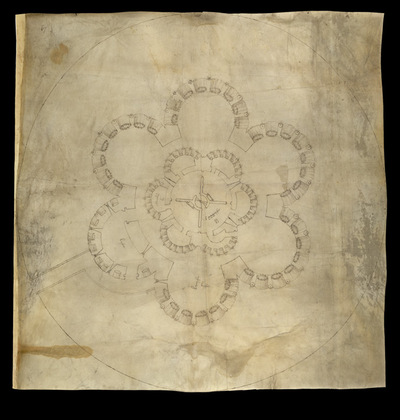Javascript must be enabled to continue!
Deal Castle, Kent
View through Europeana Collections
This is a plan of Deal Castle, the Tudor
artillery fort dating from around 1539. One of a chain of castles
along the south coast of England commission by Henry VIII to
protect the Downs Anchorage and the ‘invasion coast’ Deal would
have been an importance defence fortress. Fortification of large
sections of coast was carried out at this time as Henry VIII feared
an invasion from the combined forces of France and Spain. In 1538
Francis I of France, and Charles V Holy Roman Emperor and King of
Spain signed a peace treaty. This union gave rise to the
possibility that France and Spain may combine forces to invade
England. France was England’s historical enemy and Henry VIII’s
divorce of Catherine of Aragon, Charles V’s aunt, had offended the
militantly catholic King of Spain. This plan dates from 1539, the
year that a survey of the south coast was made in order to
construct defence for the ‘invasion beaches’ and the newly
completed dockyards at Portsmouth. When completed Deal Castle
resembled, in plan form, the emblem of the Tudor Rose. Here rows of
baskets called ‘maunds’ are shown placed along all the external
walls of large. These were filled with earth, and were commonly
used to protect members of the gun crew during battle. It is likely
that this drawing came from the drawing office of the Hampton Court
team responsible for the construction of the castles in the Downs.
The plan displays some domestic features and an ignorance of
military matters. This can be explained by the fact that the team
had previously worked on the royal palaces. Subsequent castle
designs display a growth in understanding. Richard Benese was the
surveyor, with William Clement and Christopher Dickenson working as
master carpenter and master mason. There is some variation between
this plan and the castle that was built, the distance of the outer
curtain from the central block, the projection of the outer
bastions, the interior arrangement of the keep and the number and
disposition of guns were all altered. The outer walls were also of
a greater thickness when built, being 14 feet thick as opposed to
11 feet 6 inches shown here.
Title: Deal Castle, Kent
Description:
This is a plan of Deal Castle, the Tudor
artillery fort dating from around 1539.
One of a chain of castles
along the south coast of England commission by Henry VIII to
protect the Downs Anchorage and the ‘invasion coast’ Deal would
have been an importance defence fortress.
Fortification of large
sections of coast was carried out at this time as Henry VIII feared
an invasion from the combined forces of France and Spain.
In 1538
Francis I of France, and Charles V Holy Roman Emperor and King of
Spain signed a peace treaty.
This union gave rise to the
possibility that France and Spain may combine forces to invade
England.
France was England’s historical enemy and Henry VIII’s
divorce of Catherine of Aragon, Charles V’s aunt, had offended the
militantly catholic King of Spain.
This plan dates from 1539, the
year that a survey of the south coast was made in order to
construct defence for the ‘invasion beaches’ and the newly
completed dockyards at Portsmouth.
When completed Deal Castle
resembled, in plan form, the emblem of the Tudor Rose.
Here rows of
baskets called ‘maunds’ are shown placed along all the external
walls of large.
These were filled with earth, and were commonly
used to protect members of the gun crew during battle.
It is likely
that this drawing came from the drawing office of the Hampton Court
team responsible for the construction of the castles in the Downs.
The plan displays some domestic features and an ignorance of
military matters.
This can be explained by the fact that the team
had previously worked on the royal palaces.
Subsequent castle
designs display a growth in understanding.
Richard Benese was the
surveyor, with William Clement and Christopher Dickenson working as
master carpenter and master mason.
There is some variation between
this plan and the castle that was built, the distance of the outer
curtain from the central block, the projection of the outer
bastions, the interior arrangement of the keep and the number and
disposition of guns were all altered.
The outer walls were also of
a greater thickness when built, being 14 feet thick as opposed to
11 feet 6 inches shown here.
Related Results
Dance belt
Dance belt
362-187Hopi woven belt, faja (TK); wool; l. 239 cm., w. 9 cm.; ca. 1880.\Such belts were usually used by women to secure their dress, but on ceremonial occasions men adopted these ...
Untitled (group photograph)
Untitled (group photograph)
Sitter information:
Madame Sauturce(?)
H.R.H. the Prince of Wales, Albert Edward (1841-1910)
Sir William Hart Dyke Bt. The Right Honorable Sir William Hart Dyke 7th Bt. (7...
Untitled (eight photos, clockwise from upper left, Lady Alice Henniker; William Dyke, Esq; Hon. J. Henniker; Lady Audrey Townshend (w/bird); Lady Edith Ferguson (w/child); Hon. Emilie White; Augustus Lumley, Esq; center, Hon Harry Bourke & Montague Guest)
Untitled (eight photos, clockwise from upper left, Lady Alice Henniker; William Dyke, Esq; Hon. J. Henniker; Lady Audrey Townshend (w/bird); Lady Edith Ferguson (w/child); Hon. Emilie White; Augustus Lumley, Esq; center, Hon Harry Bourke & Montague Guest)
Sitter information:
Lady Alice Henniker. Alice Mary (d. 19 November 1893) only daughter of the 3rd Earl of Dessart. Married John Major Henniker, 14 January 1864, who succeeded ...
painting (oil): ["A Peasant Carrying a Pole"]
painting (oil): ["A Peasant Carrying a Pole"]
In the foreground is a man carrying a long pole over his left shoulder. He wears a blue hat and brown coat and black trousers with gaiters. His mouth is open as if he was calling o...
Ruins of Wilton Castle belonging to Sir [Step] Fox
Bart.
Ruins of Wilton Castle belonging to Sir [Step] Fox
Bart.
Sketch of the ruins of Wilton Castle at near
Redcar. This is presumably the remains of a medieval building,
possibly a castle or fortified manor house. Langdale's Yorkshire
Diction...
The Castle of the Pyrenees
The Castle of the Pyrenees
Belgian Surrealist René Magritte’s masterpiece The Castle of the Pyrenees was commissioned by the artist’s longtime friend, the international lawyer, poet, and author Harry Torczyn...
Castle in landscape
Castle in landscape
A watercolour painting of a Castle in landscape. It is drawn in pencil and is incribed Bow & Arrow Castle (Pensonslina Castle)? 14th July/67in ink. There are various other annotati...
painting (watercolour): ["Twilight-Stirling"]
painting (watercolour): ["Twilight-Stirling"]
Landscape with Stirling Castle looming high on a mountainside. The mountain and castle are in silhouette with a few yellow lights twinkling in the castle. In the foreground, a man ...
Recent Results
ANGLIAE, SCOTIAE & Hiberniae Nova Descriptio - Plate
1
ANGLIAE, SCOTIAE & Hiberniae Nova Descriptio - Plate
1
This map of the British Isles is by Gerard
Mercator. It dates from 1564 and was produced in Duisburg. It was a
major new depiction of the British Isles at the time. It is a giant
m...
Triptych: The Last Judgment
Triptych: The Last Judgment
Painted enamels on copper partly gilded., French...
ANGLIAE, SCOTIAE & Hiberniae Nova Descriptio - Plate
6
ANGLIAE, SCOTIAE & Hiberniae Nova Descriptio - Plate
6
This map of the British Isles is by Gerard
Mercator. It dates from 1564 and was produced in Duisburg. It was a
major new depiction of the British Isles at the time. It is a giant
m...




